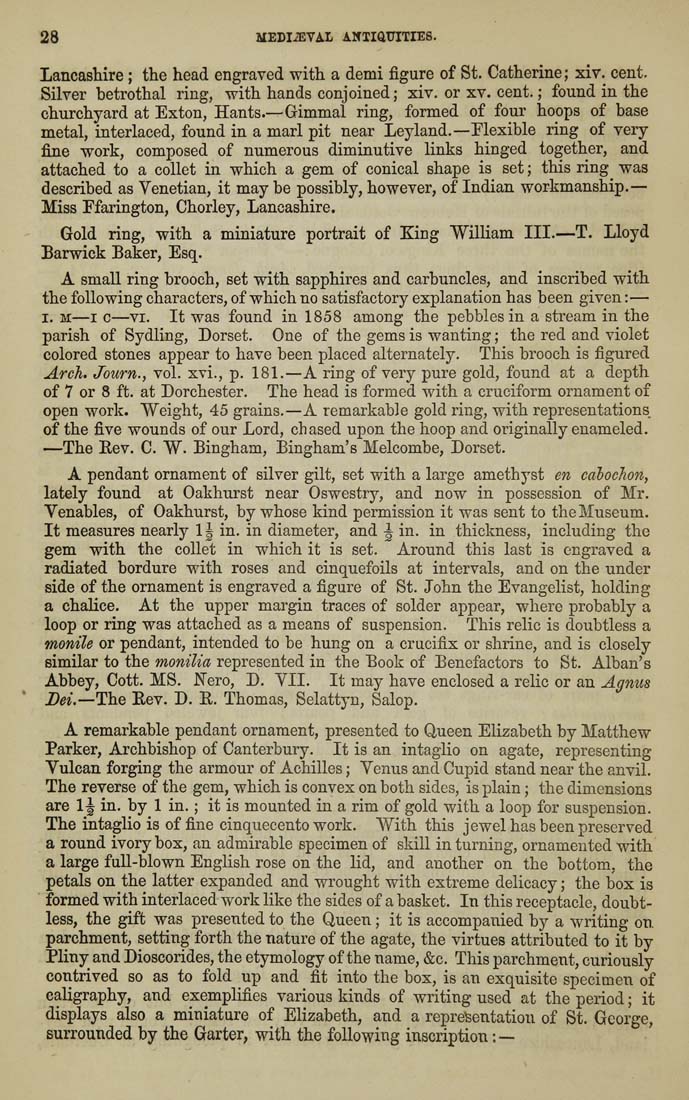28
medieval antiquities.
Lancashire; the head engraved with a demi figure of St. Catherine; xir. cent.
Silver betrothal ring, with hands conjoined; xiv. or xv. cent.; found in the
churchyard at Exton, Hants.—Gimmal ring, formed of four hoops of base
metal, interlaced, found in a marl pit near Leyland.—Flexible ring of very
fine work, composed of numerous diminutive links hinged together, and
attached to a collet in which a gem of conical shape is set; this ring was
described as Venetian, it may be possibly, however, of Indian workmanship.—
Miss Ffarington, Chorley, Lancashire.
Gold ring, with a miniature portrait of King William III.—T. Lloyd
Barwick Baker, Esq.
A small ring brooch, set with sapphires and carbuncles, and inscribed with
the following characters, of which no satisfactory explanation has been given:—
I. M—I o—vi. It was found in 1858 among the pebbles in a stream in the
parish of Sydling, Dorset. One of the gems is wanting; the red and violet
colored stones appear to have been placed alternately. This brooch is figured
Arch. Journ., vol. xvi., p. 181.—A ring of very pure gold, found at a depth
of 7 or 8 ft. at Dorchester. The head is formed with a cruciform ornament of
open work. Weight, 45 grains.—A remarkable gold ring, with representations
of the five wounds of our Lord, chased upon the hoop and originally enameled.
—The Rev. C. W. Bingham, Bingham's Melcombe, Dorset.
A pendant ornament of silver gilt, set with a large amethyst en cabochon,
lately found at Oakhurst near Oswestry, and now in possession of Mr.
Venables, of Oakhurst, by whose kind permission it was sent to the Museum.
It measures nearly 11 in. in diameter, and J in. in thickness, including the
gem with the collet in which it is set. Around this last is engraved a
radiated bordure with roses and cinquefoils at intervals, and on the under
side of the ornament is engraved a figure of St. John the Evangelist, holding
a chalice. At the upper margin traces of solder appear, where probably a
loop or ring was attached as a means of suspension. This relic is doubtless a
monile or pendant, intended to be hung on a crucifix or shrine, and is closely
Bimilar to the monilia represented in the Book of Benefactors to St. Alban's
Abbey, Cott. MS. Nero, D. VII. It may have enclosed a relic or an Agnus
Dei.—The Rev. D. R. Thomas, Selattyn, Salop.
A remarkable pendant ornament, presented to Queen Elizabeth by Matthew
Parker, Archbishop of Canterbury. It is an intaglio on agate, representing
Vulcan forging the armour of Achilles; Venus and Cupid stand near the anvil.
The reverse of the gem, which is convex on both sides, is plain; the dimensions
are 1J in. by 1 in.; it is mounted in a rim of gold with a loop for suspension.
The intaglio is of fine cinquecento work. With this jewel has been preserved
a round ivory box, an admirable specimen of skill in turning, ornamented with
a large full-blown English rose on the lid, and another on the bottom, the
petals on the latter expanded and wrought with extreme delicacy; the box is
formed with interlaced work like the sides of a basket. In this receptacle, doubt¬
less, the gift was presented to the Queen; it is accompanied by a writing on
parchment, setting forth the nature of the agate, the virtues attributed to it by
Pliny and Dioscorides, the etymology of the name, &c. This parchment, curiously
contrived so as to fold up and fit into the box, is an exquisite specimen of
ealigraphy, and exemplifies various kinds of writing used at the period; it
displays also a miniature of Elizabeth, and a representation of St. George,
surrounded by the Garter, with the following inscription: —
|








